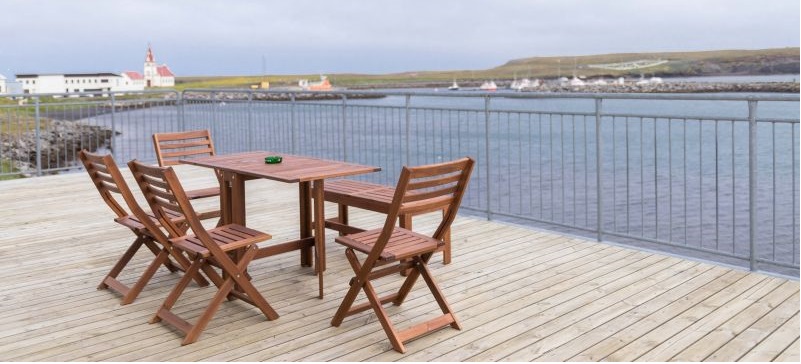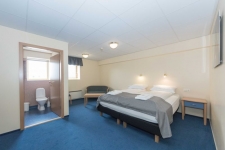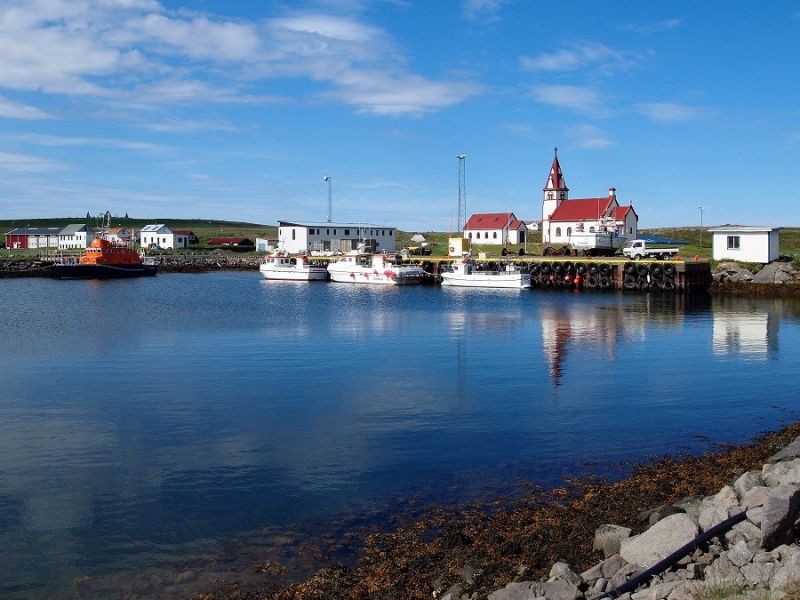Hótel Norðurljós (Hotel Northern Lights) has been a part of the history of Raufarhöfn for the last 40 years.
There are 15 en suite rooms, restaurant for around 80 guests and a bar. Walking routes are in and around the village. There is also a swimming pool in the village.
The hotel is located in the old part of village, down by the harbor. There is a wonderful sea view from the restaurant. Also there is a view over the harbor where one can sometime see the fishermen prepare their boats and fish factory workers take a stroll in the fresh air.
The restaurant offers a variety of meals and great fish dishes.
The Hotel was originally built as accommodation for workers employed in the fish processing industry and at times was the home for up to 200 “herring-girls” who came in the summer months to salt herring at the “Odin”s Station”. Towards the end of the “herring adventure” at the end of the 1960”s this place was converted into a hotel. To begin with the hotel was run as a summer hotel but during the last five years it has stayed open throughout the year. The bulding has been extensively renovated. There is a lounge in the hotel for the use of guests as well as a study with books in English, dealing with all aspects of Icelandic nature. The restaurant serves a variety of local and international dishes. The bar provides excellent views across the harbour.
The hotel is located near the centre of the quayside with a view across the harbour where it is possible to observe the fishermen in the afternoon when they land their catch from their small fishing boats. Bigger fishing boats may also be seen coming and going. To the west of the hotel is an open space where the arctic tern nests as well as the golden plover and several other species of birds. A lot of birds can also be
observed in the harbour area and further away is the Höfðinn, a nesting place for many species. 20 species of birds have been spotted from the windows of the hotel.
From the immemorial man has found within himself some need to get away from the humdrum things of everyday life and return to unspoilt nature to feel alive again. This is – to give examples- what the Saviour did when he went into the wilderness and what Moses did when he ascended Mount Sinai. All by himself and faced with nature itself man realizes his own slight stature and becomes more ready to submit to nature”s laws and whims. Grand and over helming features disappear and are replaced by small things found at every footstep. Instinctively man”s attention is drawn to things in nature. He becomes oblivious of his own problems for a moment and allows his surroundings to envelop him and he becomes one with his
surroundings. Humbly he submits to the Omnipotent Power and is grateful for being a participant in the complex system that nature represents.
This need has, if anything, become more and more pronounced and now the time has come that man increasingly seeks nature in his leisure time. Modern industrialzation has unfortunately been brought on at nature”s expense. In Europe, and in many other places, birds, mammals and vegetation have had to retread at the approach of technology. At present there are few places in Europe which can pride themselves on having virgin land within their reach. Iceland is the country in Europe that still has untouched pearls of nature. The North-east part of Iceland is the part that is among the richest ones in this respect.
The village of Raufarhöfn is the community that lies farthest north in Iceland. It is located in the eastern part of the Sléttan (Melrakkasétta) close to the Arctic Circle. The population of Raufarhöfn is about 200 and most of the people there earn their living from fishing and fish processing. During the so-called “herring-years” and until 1967 Raufarhöfn was one of the busiest places processing herring in Iceland. There was a herring factory in the village and herring was salted into barrels at the herring stations in the village. In those years the population at times became tenfold the number of permanent residents as the “herring-girls” arrived in hordes for doing the salting of the herring and the herring boats came in to land their cactch. This is now part of history as the herring disappeared in 1967 with most of the things and atmosphere that accompanied it. Few things remain in the village which remind us of those years as new ground was broken for new means of livelihood. Today some big fishing ships of multi-purpose design are run from Raufarhöfn as well as a great number of small fishing boats. There is a modern fish processing factory in the village and a fishmeal factory as well as some smaller business concern. Despite there being relatively few permanent residents in the village, things look lively in the harbour area all around the year. Small fishing boats sail into the harbour in the afternoon and so do other fishing boats set very low in the sea that at times flows over the main deck because of the huge catches of capelin or herring on board. Freighters and sailing boats can also be seen at times coming into the harbour. The harbour is very beautiful and partly shaped by nature itself. Varied birdlife can be observed in and around the harbour.
There are good facilities for pursuing sports at Raufarhöfn. The village has a modern and well-equipped sports hall, a swimming pool and an outdoor sport area. A wide and untouched open area surronds the village with a lot of birds and varied vegetation. In summer one will observe wild migratory birds within the village being a part of the village life with the villagers most often waking up in the morning to the songs of
birds. It may seem strange but it is as if nature wakes up and becomes alive twice a day, namely in the morning and again in the evening when the midnight sun pours its golden beams across the land and the sea and the breeze dies down. The coastline with its inlets and creeks is filled with driftwood and reaches
out into the Arctic Sea. Away and on the surface of the sea various sea-birds will be spotted and a occasional seal. On the beach waders strut and inland on the grassy moorlands there are dozens of lakes filled with trout. In the vicinity many species of ducks, waders and species that favor heaths and moorlands may be observed.




